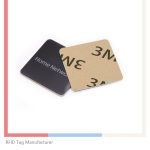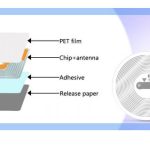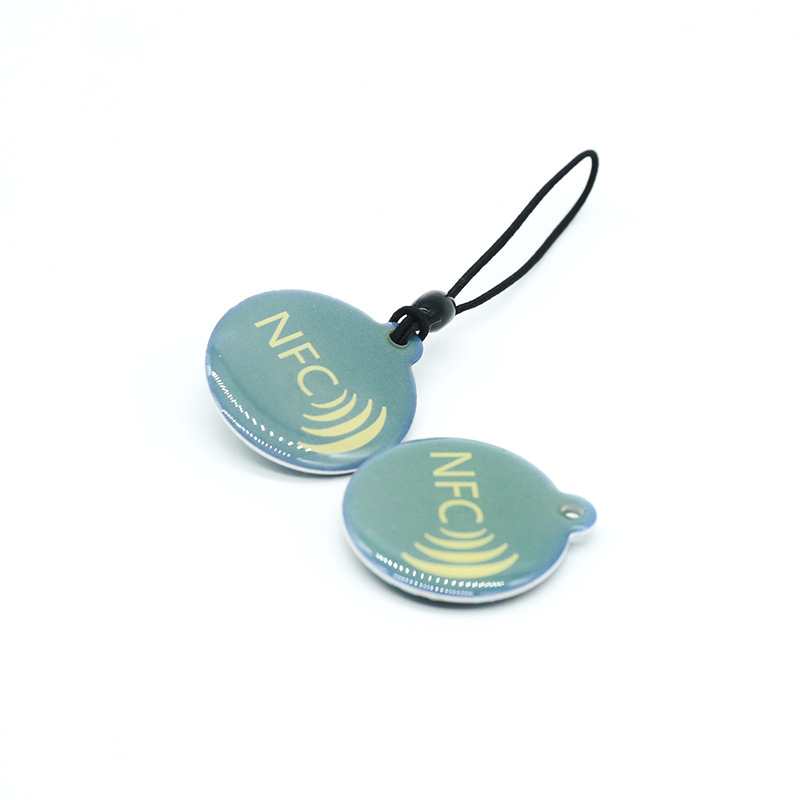What is the NFC Tag?

NFC tag is a small sticker or card that contains a chip and an antenna that can store and transmit data using NFC (Near Field Communication) technology. NFC is a wireless communication method that allows devices to exchange information over short distances, usually less than 10 cm. NFC tag is compatible with most NFC-enabled devices, such as smartphones, tablets, laptops, etc. You can use NFC tag for various purposes, such as launching apps, opening websites, sharing contacts, making payments, and more.
Components of an NFC Tag

An NFC tag consists of two main components: a chip and an antenna. The chip is the brain of the tag, which stores the data and controls the communication with the reader device. The antenna is the coil of copper wire that enables the wireless transmission of data and power. The chip and the antenna are usually embedded in a plastic or paper substrate, which can have different shapes and sizes.
The chip of an NFC tag can have different memory capacities and features, depending on the type and manufacturer. Some common features of NFC chips are:
Memory size: The amount of data that can be stored on the tag, ranging from a few bytes to several kilobytes.
Data protection: The ability to lock or encrypt the data on the tag to prevent unauthorized access or modification.
Originality signature: The ability to verify the authenticity of the tag and its manufacturer.
Data retention: The ability to preserve the data on the tag for a long period of time, usually up to 10 years.
The antenna of an NFC tag can have different shapes and sizes, depending on the design and application. Some common shapes of NFC antennas are:
Square or circular: The most common shape of NFC antennas, which can fit in various form factors, such as stickers, cards, keychains, etc.
Rectangular or oval: A shape of NFC antennas that can cover a larger surface area, such as posters, labels, etc.
Loop or spiral: A shape of NFC antennas that can work on metal surfaces, which are usually not compatible with regular NFC antennas due to interference.
How to Check Whether Your Smartphone is NFC-Enabled?
To use an NFC tag with your smartphone, you need to make sure that your smartphone is NFC-enabled. This means that your smartphone has a built-in NFC reader that can communicate with NFC tags. Most smartphones these days have NFC functionality, but some older models may not support it.
To check whether your smartphone is NFC-enabled, you can follow these steps:
Go to your smartphone’s settings menu and look for an option related to wireless or connectivity.
Look for an option named NFC or near field communication and see if it is turned on or off.
If it is turned on, your smartphone is NFC-enabled and you can use it with NFC tags.
If it is turned off or not available, your smartphone is not NFC-enabled and you cannot use it with NFC tags.
Alternatively, you can also look for an NFC logo on your smartphone’s body or packaging. The logo usually looks like a stylized N with four curved lines around it. If you see this logo on your smartphone, it means that it is NFC-enabled.
How NFC Tags Work
NFC tags work by using electromagnetic induction to transfer data and power between two devices that are in close proximity to each other. When an NFC reader device (such as a smartphone) approaches an NFC tag (such as a sticker), the reader device generates a magnetic field that energizes the tag. The tag then sends its stored data to the reader device in the form of electromagnetic pulses. The reader device decodes these pulses and performs the corresponding action.
The communication between an NFC reader device and an NFC tag follows a standard protocol defined by the NFC Forum, which is an industry association that promotes and regulates the use of NFC technology. The protocol specifies how the devices should initiate, maintain, and terminate the communication, as well as how they should exchange data.
The communication between an NFC reader device and an NFC tag can be either active or passive. In active mode, both devices generate their own magnetic fields and exchange data bidirectionally. In passive mode, only one device (usually the reader device) generates a magnetic field and powers the other device (usually the tag), which only sends data unidirectionally.
6 Main Forum Types of NFC Tags
Type 1: This type of tag has a memory size of 96 bytes, which can be expanded to 2 kilobytes. It has a data transfer rate of 106 kilobits per second. It can be read and written multiple times, and can also be locked to make the data read-only. It is based on the ISO/IEC 14443A standard and uses the Topaz chip by Broadcom.
Type 2: This type of tag has a memory size of 48 bytes, which can be expanded to 2 kilobytes. It has a data transfer rate of 106 kilobits per second. It can be read and written multiple times, and can also be locked to make the data read-only. It is based on the ISO/IEC 14443A standard and uses the MIFARE Ultralight or NTAG chip by NXP Semiconductors.
Type 3: This type of tag has a memory size of up to 1 megabyte. It has a data transfer rate of 212 kilobits per second or 424 kilobits per second. It can be read and written multiple times, and can also be locked to make the data read-only. It is based on the Japanese Industrial Standard (JIS) X 6319-4 and uses the FeliCa chip by Sony.
Type 4: This type of tag has a memory size of up to 32 kilobytes. It has a data transfer rate of up to 424 kilobits per second. It can be read and written multiple times, and supports data encryption and authentication. It is based on the ISO/IEC 14443A/B standard and uses the MIFARE DESFire or SmartMX chip by NXP Semiconductors or the SLE chip by Infineon Technologies.
Type 5: This type of tag has a memory size of up to 64 kilobytes. It has a data transfer rate of up to 26.48 kilobits per second. It can be read and written multiple times, and supports data encryption and authentication. It is based on the ISO/IEC 15693 standard and uses various chips by different manufacturers, such as STMicroelectronics, Texas Instruments, etc.
Type 6: This type of tag has a memory size of up to 8 kilobytes. It has a data transfer rate of up to 26.48 kilobits per second. It can be read and written multiple times, and supports data encryption and authentication. It is based on the ISO/IEC 15693 standard and uses the Tag-it chip by Texas Instruments.
Uses of NFC Tags
NFC tags have many uses in different domains and scenarios, such as:
Marketing: You can use NFC tags to promote your products or services by embedding them in posters, flyers, brochures, etc. You can also use them to offer discounts, coupons, loyalty programs, etc. to your customers by embedding them in cards, stickers, keychains, etc.
Entertainment: You can use NFC tags to enhance your gaming experience by embedding them in toys, figurines, cards, etc. You can also use them to access digital content by embedding them in books, magazines, DVDs, etc.
Education: You can use NFC tags to facilitate learning by embedding them in textbooks, flashcards, maps, etc. You can also use them to track attendance, grades, assignments, etc. by embedding them in badges, cards, stickers, etc.
Healthcare: You can use NFC tags to improve your health and wellness by embedding them in wristbands, bracelets, patches, etc. You can also use them to monitor your vital signs, medication, allergies, etc. by embedding them in medical devices, implants, tags, etc.
Transportation: You can use NFC tags to simplify your travel by embedding them in tickets, passes, cards, etc. You can also use them to access public transportation, parking, tolls, etc. by embedding them in vehicles, bikes, scooters, etc.
Home: You can use NFC tags to automate your home by embedding them in appliances, lights, switches, etc. You can also use them to control your smart devices, such as speakers, cameras, thermostats, etc. by embedding them in remotes, buttons, stickers, etc.
How to Choose NFC Tag Chips
When choosing an NFC tag chip for your application, you need to consider several factors, such as:
Memory size: The amount of data that you want to store on the tag, such as URL, text, contact information, etc.
Data protection: The level of security that you want to apply to the data on the tag, such as locking, encryption, authentication, etc.
Data retention: The duration that you want to preserve the data on the tag, usually up to 10 years.
Data transfer rate: The speed that you want to exchange data between the tag and the reader device, usually from 106 kilobits per second to 424 kilobits per second.
Compatibility: The compatibility that you want to ensure between the tag and the reader device, usually based on the NFC Forum Type specifications or the ISO/IEC standards.
Cost: The cost that you want to spend on buying or producing the tag, usually depending on the memory size, features, and quantity.
Based on these factors, you can choose the best NFC tag chip for your application from various options available in the market.
Where Can You Buy NFC Tags
If you want to buy NFC tags for your personal or professional use, You can buy NFC tags online from www.rfidtagmaker.com that sell different types of NFC tags with different features and prices.
RFID Tag Maker is one of the largest NFC tag manufacturer that sells a wide range of NFC tags,NFC business card, NFC keyfob, NFC reader. You can find various types of NFC tags with different sizes, shapes, colors, memory capacities and features from RFID Tag Maker.
we provides fast delivery,competitive prices,and excellent customer service. You can contact us for more information.
Which NFC Tag Type is Best?
The best NFC tag type for a specific application ultimately depends on the unique needs and requirements of that particular situation. Some factors to consider include storage capacity, security measures, transmission rate, physical durability, and cost.
However, only use Type 1 if you’re on a tight budget and need to store very little data. Type 2 tags are also affordable and offer slightly better storage capacity, making them suitable for low-security marketing campaigns or product packaging.
For high-capacity tasks and secure storage of sensitive information, consider Type 3 or 4 tags. And if you’re looking for a rugged option for industrial use, Type 5 tags may be the best choice.
how to buy nfc tags?
The choice of NFC tag type depends on the application requirements and the trade-offs between cost, performance and compatibility. You should consider the following factors when choosing an NFC tag type:
Memory size: How much data do you need to store on the NFC tag?
Data format: Do you need to use a standardized data format (NDEF) or a proprietary one?
Communication speed: How fast do you need to transfer data between the tag and the device?
Security: How important is the protection of data and authentication of the tag?
Compatibility: What devices and systems do you need to interact with the tag?
Availability: How easy is it to find and buy the tag type you need?
Cost: How much are you willing to pay for the tag type you need?
Different NFC tag types have different advantages and disadvantages depending on their technical features, memory size, data format and compatibility. Some of the common NFC tag types are:
NFC Type 1: Based on ISO 14443A standard, read/write capable, can be set to read-only, 96 bytes of memory, communication speed of 106 kbit/s, compatible with NFC Forum Type 1 Tag and Topaz IC products. Advantages: low cost, ideal for many NFC applications. Disadvantages: low memory, low speed, limited availability.
NFC Type 2: Based on ISO 14443A standard, read/write capable, can be set to read-only, 48 bytes of memory (up to 2 kbyte), communication speed of 106 kbit/s, compatible with NFC Forum Type 2 Tag and MIFARE Ultralight products. Advantages: low cost, widely available, flexible memory options. Disadvantages: low speed, limited security features.
NFC Type 3: Based on Sony FeliCa system, read/write capable, can be set to read-only, variable memory up to 1 Mbyte, communication speed of 212 kbit/s or 424 kbit/s, compatible with NFC Forum Type 3 Tag and FeliCa products. Advantages: high speed, high security, high reliability. Disadvantages: high cost, limited availability outside Japan.
NFC Type 4: Based on ISO 14443A and B standards, read/write capable or read-only (fixed at manufacture), variable memory up to 32 kbyte, communication speed of 106 kbit/s or 424 kbit/s, compatible with NFC Forum Type 4 Tag and MIFARE DESFire products. Advantages: high security, flexible data format (NDEF), dynamic memory structure. Disadvantages: high cost, complex implementation.
NFC Type 5: Based on ISO 15693 standard, read/write capable or read-only (fixed at manufacture), variable memory up to 64 kbyte, communication speed of 26.48 kbit/s, compatible with NFC Forum Type 5 Tag and ICODE products. Advantages: long range (up to 1.5 m), anti-collision support, low power consumption. Disadvantages: low speed, limited security features.
Chip Memory User Memory Max URL Scan Counter Password Auth
MIFARE Ultralight 64 48 40
MIFARE Ultralight EV1 (80byte) 80 48 40 Yes
MIFARE Ultralight EV1 (164byte) 164 128 120 Yes
NTAG203(discontinued) 168 144 136*
NTAG210µ 64 48 40
NTAG210 80 48 40 Yes
NTAG213 180 144 136* Yes Yes
NTAG215 540 504 492 Yes Yes
NTAG216 924 888 854 Yes Yes
NTAG424 - 256** 240 Yes Yes Yes
NTAG213 TT tbc tbc tbc Yes Yes
ST25TN01K 256 160 152
ST25TN512 256 64 56
NTAG426Q - 916** - Yes Yes Yes
NTAG223 - 144** - Yes Yes Yes
NTAG224 - 207** - Yes Yes Yes
Where can you buy nfc tags
There are different ways to buy NFC tags depending on your needs and preferences. You can buy NFC tags online from various websites that offer a wide range of products, such as GoToTags Store¹, Amazon² or atlasRFIDstore³. You can choose the NFC tag type, size, shape, memory and design that suit your application. You can also customize your NFC tags with printing, encoding and testing services.
Alternatively, you can buy NFC tags from local stores that sell electronic devices or accessories. You can check the availability and compatibility of the NFC tags with your NFC enabled phone or device before buying them. You can also ask for advice or assistance from the store staff if you have any questions or issues.
NFC tags are small, inexpensive and versatile devices that can store and transfer data to other NFC enabled devices. They can be used for various purposes such as contactless payment, smart poster, product authentication, loyalty program, etc. You can buy NFC tags easily and conveniently from online or offline sources according to your needs and preferences.
If you want to buy cheap nfc tags, you can search rfiddtagmaker.com. RFID Tag Maker is a factory specializing in the production of RFID Tag nfc tag,
Here you can customize any size, shape memory and design that suit your application, and RFID Tag Maker also supports customize your NFC tags with printing, encoding and testing services.
RFID Tag Maker is the best place to buy nfc tags.












